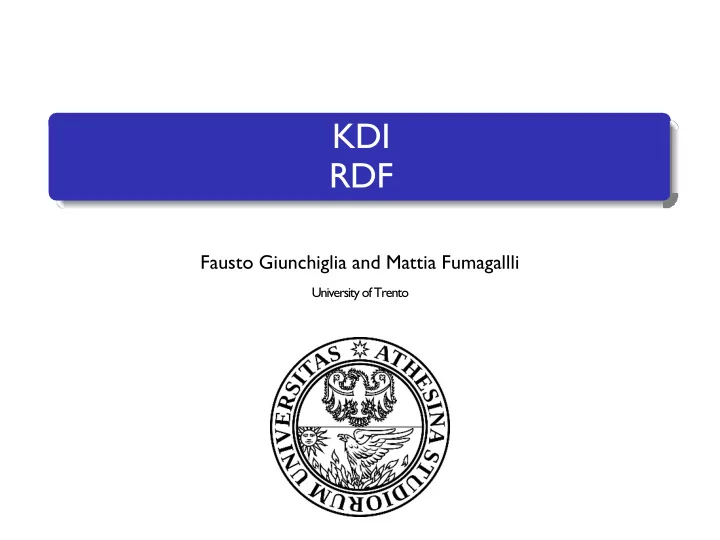

KDI RDF Fausto Giunchiglia and Mattia Fumagallli University of Trento
Title (font gill sans MT) Roadmap XML From HTML to XML Similarities and differences XML features and limits RDF Syntax Language and data model Reification Containers and collections Semantics RDF schema Reasoning Inference system Inference rules Exercises 2
XML 3 Chapter 1
Title (font gill sans MT) HTML vs. XML HTML: focus on presentation <h2>The adventures of Tom Sawyer</h2> … <b>Author: </b> Mark Twain <br> <b>Cover artist: </b> created by <a href=“http://…”>Mark Twain </a> … XML: focus on metadata <book> <title> The adventures of Tom Sawyer </title> <author> Mark Twain </author> <genre> Bildungsroman </genre> <genre> picaresque </genre> … <publisher> American Publishing Company </publisher> <year>1876</year> </book> 4
Title (font gill sans MT) HTML vs. XML: similarities and differences Similarities • They both use of tags • Tags may be nested • Human can read and interpret both HTML and XML quite easily • Machines can read and interpret only to some extent Differences HTML is to tell machines about how to interpret formatting for graphical presentation XML is to tell machines about metadata content and relationships between different pieces of information XML allows the definition of constraints on values HTML tags are fixed, while XML tags are user defined 5
Title (font gill sans MT) More about XML XML meta markup language: language for defining markup languages Query languages for XML: Xquery XQL XML-QLs Style sheets can be written in various languages to define how to present XML to humans: CSS2 (cascading style sheets level 2) XSL (extensible stylesheet language) Transformations: XSLT specifies rules to transform an XML document to: another XML document an HTML document plain text 6
Title (font gill sans MT) XML in a nutshell XML features: A metalanguage that allows users to define markup It separates content and structure from formatting It is the de facto standard for the representation and exchange of structured information on the Web It is supported by query languages XML limits: The semantics of XML documents is not accessible to machines The nesting of tags does not have standard meaning Interoperability is possible if there is a shared understanding of the vocabulary 7
RDF 8 Chapter 1
Title (font gill sans MT) RDF and the Semantic Web RDF (Resource Description Framework) is at the basis of the Semantic Web Definitions A language for representing Web resources and information about them in the form of metadata [RDF Primer] A language to represent all kinds of things that can be identified on the Web [RDF Primer] A domain independent data model for representing information on the Web [G. Antoniou and F. van Harmelen, 2004] A language with an underlying model designed to publish data on the Semantic Web [F. Giunchiglia et al., 2010] 9
Title (font gill sans MT) Distributing Data Across the Web WORKS ID Title Author Medium Year 1 Hamlet Shakespeare Play 1599 2 Othello Shakespeare Play 1604 SUBJECTS 3 Edward II C. Marlowe Play 1592 VALUE 4 Hero and C. Marlowe Poem 1593 Leander PROPERTIES Data Distribution (over many machines where each machine maintains a part) row by row column by column cell by cell (the strategy taken by RDF): a global identifier for the column headings a global identifier for the row headings a global identifier for non-literal values 10
RDF syntax 11 Chapter 1
Title (font gill sans MT) RDF language and data model RDF language A language for representing data in the Semantic Web A language for expressing simple statements of the form subject-property-value (binary predicates) The capability to perform inference on statements RDF data model The data model in RDF is a graph data model An edge with two connecting nodes forms a triple property subject value 12
Title (font gill sans MT) RDF language Formal syntax: RDF has been given a syntax in XML and inherits all its benefits Statements in RDF are machine comprehensible Resources: An object, an entity or anything we want to talk about (e.g. authors, books, publishers, places, people, facilities) Properties: They codify relations (e.g. written-by, friend-of, located-in, …) and attributes (e.g. age, date of birth, length …) Statements: Statements assert the properties of resources in form of triples subject-property-value Every resource and property has a URI (an URL or any other identifier) Values can be resources (for relations) or literals (for attributes) 13
Title (font gill sans MT) RDF data model http://www.geonames.org http://www.geonames.org/countries http://purl.org/dc/terms/coverage RELATION resource resource http://www.geonames.org September 25, 2015 http://purl.org/dc/terms/modified ATTRIBUTE resource literal 14
Title (font gill sans MT) RDF as graph http://www.geonames.org http://www.geonames.org/countries http://purl.org/dc/terms/coverage resource resource September 25, 2015 literal 15
Title (font gill sans MT) XML syntax example <?xml version=“1.0”?> <rdf:RDF xmlns:rdf="http://www.w3.org/1999/02/22-rdf-syntax-ns#" xmlns:rdfs="http://www.w3.org/2000/01/rdf-schema#" xmlns:dc="http://purl.org/dc/terms#"> <rdf:Description rdf:about="http://www.geonames.org"> <rdfs:label>GeoNames</rdfs:label> <dc:coverage rdf:resource="http://www.geonames.org/countries"/> <dc:modified>September 25, 2015</dc:modified> </rdf:Description> </rdf:RDF> 16
Title (font gill sans MT) RDF/XML elements <?xml version=“1.0”?> <rdf:RDF xmlns:rdf="http://www.w3.org/1999/02/22-rdf-syntax-ns#" xmlns:xsd="http://www.w3.org/2001/XMLSchema#" NAMESPACES xmlns:uni="http://www.mydomain.org/uni-ns"> URI or fragment of it VALUE <rdf:Description rdf:about=“CIT1111”> <uni:courseName>Discrete Matematics</uni:courseName> RESOURCE HAS <uni:isTaughtBy rdf:resource=“#949318”> RELATION BEEN <uni:age rdf:datatype="&xsd:integer">27<uni:age> ATTRIBUTE DEFINED </rdf:Description> ELSEWHERE DATA TYPE <rdf:Description rdf:ID=“#949318"> <uni:name>David Billington</uni:name> RESOURCE IS <uni:title>Associate Professor</uni:title> DEFINED HERE <uni:age rdf:datatype="&xsd:integer">27<uni:age> </rdf:Description> 17 </rdf:RDF>
Title (font gill sans MT) RDF typing <rdf:Description rdf:ID="CIT1111"> <rdf:type rdf:resource="http://www.mydomain.org/uni- ns#course"/> <uni:courseName>Discrete Maths</uni:courseName> <uni:isTaughtBy rdf:resource="#949318"/> </rdf:Description> <rdf:Description rdf:ID="949318"> <rdf:type rdf:resource="http://www.mydomain.org/uni- ns#lecturer"/> <uni:name>David Billington</uni:name> <uni:title>Associate Professor</uni:title> </rdf:Description> 18
Title (font gill sans MT) RDF Reification Reification can be used to represent: Generic statements about statements Structured attributes (e.g. address) Units of measure Provenance information Time validity and other contextual information capital Rome Roman Empire statement#12345 startDate endDate 27 BC 476 AD 19
Title (font gill sans MT) RDF Reification: example In the following it represents the fact that “the item 10245 (basically a tent) has weight 2.4 (in some measuring unit, e.g., kg)” and “the staff with id 85740 has written this statement” <?xml version="1.0"?> <!DOCTYPE rdf:RDF [<!ENTITY xsd "http://www.w3.org/2001/XMLSchema#">]> <rdf:RDF xmlns:rdf="http://www.w3.org/1999/02/22-rdf-syntax-ns#" xmlns:dc="http://purl.org/dc/elements/1.1/" xmlns:exterms="http://www.example.com/terms/" xml:base="http://www.example.com/2002/04/products"> <rdf:Description rdf:ID="item10245"> <exterms:weight rdf:datatype="&xsd;decimal">2.4</exterms:weight> </rdf:Description> Below the URI triple12345 is used to identify the original statement provided above <rdf:Statement rdf:about="#triple12345"> <rdf:subject rdf:resource="http://www.example.com/2002/04/products#item10245"/> <rdf:predicate rdf:resource="http://www.example.com/terms/weight"/> <rdf:object rdf:datatype="&xsd;decimal">2.4</rdf:object> <dc:creator rdf:resource="http://www.example.com/staffid/85740"/> </rdf:Statement> </rdf:RDF>
Recommend
More recommend